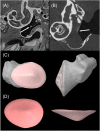Vibroacoustic Response of the Tympanic Membrane to Hyoid-Borne Sound Generated during Echolocation in Bats
- PMID: 36844389
- PMCID: PMC9949566
- DOI: 10.1093/iob/obad004
Vibroacoustic Response of the Tympanic Membrane to Hyoid-Borne Sound Generated during Echolocation in Bats
Abstract
The hyoid apparatus in laryngeally echolocating bats is unique as it forms a mechanical connection between the larynx and auditory bullae, which has been hypothesized to transfer the outgoing echolocation call to the middle ear during call emission. Previous finite element modeling (FEM) found that hyoid-borne sound can reach the bulla at an amplitude likely heard by echolocating bats; however, that study did not model how or if the signal could reach the inner ear (or cochlea). One route that sound could take is via stimulation of the eardrum-similarly to that of air-conducted sound. We used micro computed tomography (μCT) data to build models of the hyoid apparatus and middle ear from six species of bats with variable morphology. Using FEM, we ran harmonic response analyses to measure the vibroacoustic response of the tympanic membrane due to hyoid-borne sound generated during echolocation and found that hyoid-borne sound in all six species stimulated the eardrum within a range likely heard by bats. Although there was variation in the efficiency between models, there are no obvious morphological patterns to account for it. This suggests that hyoid morphology in laryngeal echolocators is likely driven by other associated functions.
© The Author(s) 2023. Published by Oxford University Press on behalf of the Society for Integrative and Comparative Biology.
Figures









References
-
- Brinkløv S, Kalko EK, Surlykke A. 2009. Intense echolocation calls from two “whispering” bats, Artibeus jamaicensis and Macrophyllum macrophyllum (Phyllostomidae). J Exp Biol 212:11–20. - PubMed
-
- Carter RT, Shaw JB, Adams RA. 2014. Ontogeny of vocalization in Jamaican fruit bats with implications for the evolution of echolocation. J Zool 293:25–32.
LinkOut - more resources
Full Text Sources
Miscellaneous
